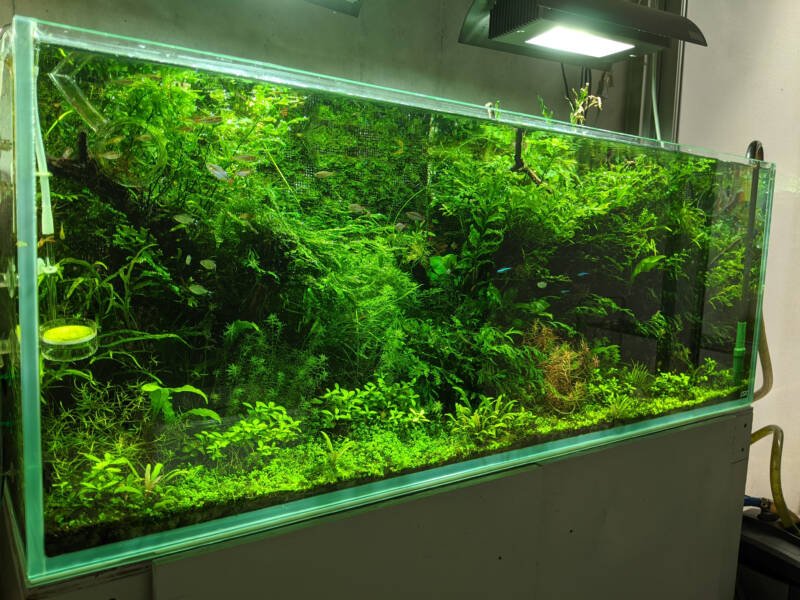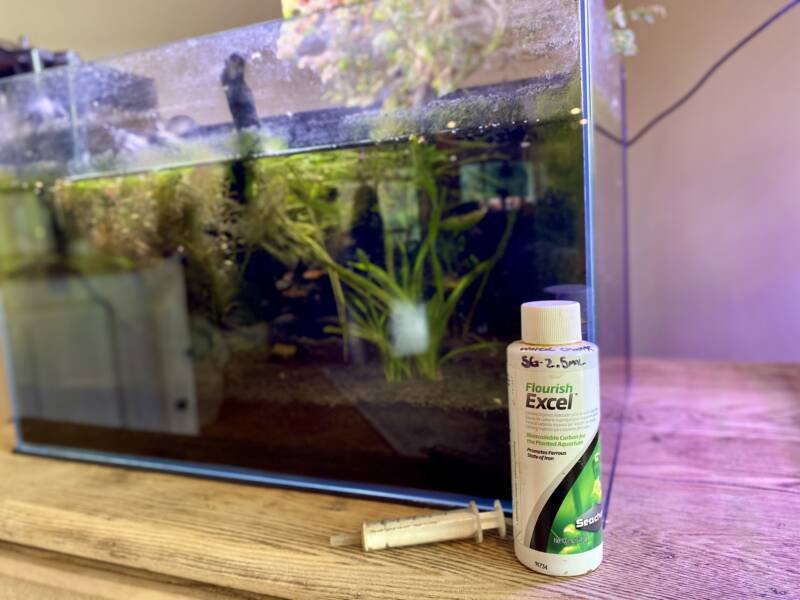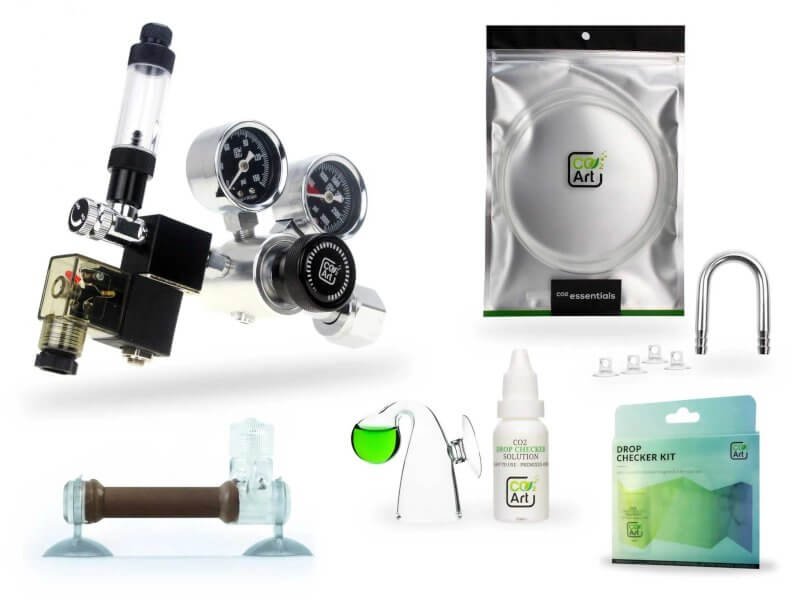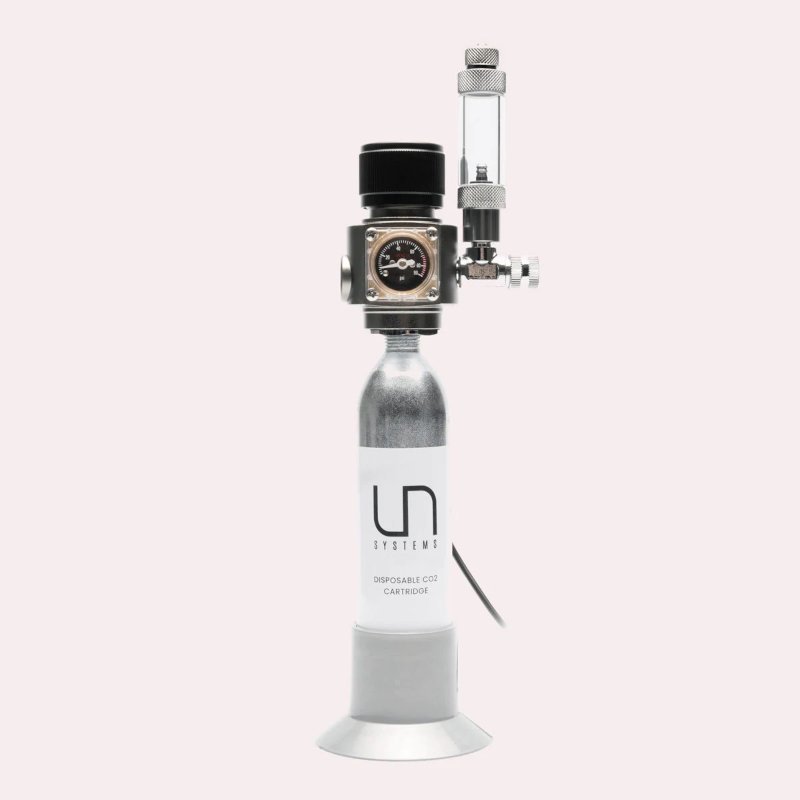One of the secrets to having success with live aquarium plants is giving the plants enough carbon. It’s an essential nutrient that is often lacking in freshwater planted aquariums.
One of the ways aquatic plants get carbon is by adsorbing it from the water.
If the plants use up the carbon supply, they stop growing. Aquatic plants will often turn yellow, drop their leaves, or simply die.
The most effective way to add carbon to your tank is by fertilizing with carbon dioxide gas.
3 Options for CO2

-
CO2 are pressurized tanks of gas. Refillable metal tanks of CO2 gas.
-
CO2 reactors. Use citric acid and sodium bicarbonate to produce a steady supply of carbon dioxide.
-
Liquid Fertilizer additives. Measured and added directly to the water.
Quick Look at Pro & Con of Each:
If you have a large aquarium, refillable tanks of CO2 are probably the way to go. The tanks are refilled at beverage distributors which are more common than you might think.
This is a complete system, with the need of special regulators, hoses and more. Tank sizes vary drastically so the frequency of refill will also vary as well as how big of a metal tank you are trying to hide behind or below your aquarium.
CO2 reactors are a more advanced set up and require more fine tuning and the use of chemicals that need more precautions handling.
Liquid fertilizers are a great option for beginners, easy and hard to mess up. The additives are moderate in cost and each bottle can last many months. Only downside is this is a frequent maintenance task added to the care of your aquarium.
All methods are effective at providing carbon fertilization for your planted aquarium.
For smaller planted aquariums up to 29 gallon the MagTool CO2 Generator is a great way to provide CO2 fertilization for your live aquarium plants. Generating your own carbon dioxide is easy and reliable with the MagTool system. The kit is designed for smaller planted aquariums and provides all the gear you need to get started.
Alternatively, go for the liquid fertilizer additive like Sechem Flourish Excel
My Top Pick Small Tank:
If you’ve got a large planted aquarium 30gal+ packed with plants, you’ll want to go with a traditional refillable CO2 tank, the CO2 Art system provides the heavy-duty equipment needed for larger pressurized CO2 tanks with greater gas flow. As a bonus this company has INCREDIBLE customer service!
My Top Pick Large Tank:
Best CO2 Complete Systems
CO2Art offers two CO2 kits designed for pressurized gas tanks. The Pro SE series uses a two-stage regulator.
Two-stage regulators have twin gauges that show the pressure in the CO2 tank and the pressure being sent to the output stage. The output stage is the pressure available at the fine-adjustment valve.
The benefit of a two-stage regulator is that you can reduce the pressure coming out of the system, making it much easier to regulate the flow rate with the fine needle valve.
You can make the adjustment by watching your CO2 diffuser or with the bubble counter.
The kit also comes with a Bazooka Flux ceramic diffuser that attaches to the glass inside the aquarium.
If you want to inject CO2 with a canister filter, the Pro SE kit with an inline diffuser is available. The Pro Elite series of kits use an advanced regulator featuring a built-in solenoid valve, fine needle valve, and bubble counter with a built-in check valve.
You can use the optional expander manifold to run CO2 to a second aquarium. The Pro Elite series includes tubing, CO2 checker and can be had with an internal or inline diffuser.
The Glass Aqua Mini CO2 System Kit comes with all the components required to set up a pressurized CO2 system for a planted aquarium.
The kit comes with a small CO2 cartridge, cartridge holder, and all CO2 injection accessories needed to add CO2 to your aquarium.
The system includes a dual-stage regulator with a bubble counter, diffuser, tubing, and check valve.
The kit comes with a paintball tank adapter, making it easy to get refills. The Glass Aqua Mini is ideal for nano planted tanks up to 10 gallons.
This CO2 system creates its own CO2 by reacting citric acid and sodium bicarbonate. The citric acid reacts with the bicarbonate to release carbon dioxide gas.
The reaction takes place in the metal cylinder, which is designed to capture the gas. A CO2 regulator controls the amount of gas released from the tank.
The kit comes with a solenoid valve that automatically turns the CO2 on and off. You’ll need to provide your own timer.
The MagTool kit comes with a bubble counter and needle valve to make it easy to see the flow rate.
The kit also provides a diffuser and suction cups along with tubing.
A funnel and measuring cup are provided for mixing the ingredients and filling the tank. You will need to purchase powdered citric acid and baking soda separately.
The MagTool CO2 Generator provides plenty of CO2 for tanks up to 40 gallons.
Aquarists with larger planted aquariums will probably want to use two units or go with traditional CO2 tanks.
The Fzone system works the same way as the MagTool. You add citric acid and bicarbonate to the tank, then add water. The reaction generates CO2 gas.
The Fzone generator comes with a pressure regulator, bubble counter, and needle valve.
You also get a diffuser and tubing along with a measuring cup and funnel. If you want a solenoid valve, it can be purchased separately.
The kit will provide enough CO2 for tanks up to about 40 gallons. Aquariums with bright lights will most likely require a larger system with a refillable tank.
This miniature CO2-dosing system uses disposable cartridges containing pressurized carbon dioxide.
Simply screw the regulator onto the top of a cartridge and attach the ceramic diffuser. CO2 slowly bubbles out of the diffuser and into the water.
The system does not come with a bubble counter or solenoid valve. You judge the gas flow by looking at the gas leaving the diffuser.
When the cartridge is empty, simply attach a new cartridge. The cartridges don’t contain a lot of gas.
The Fluval Mini is recommended for nano planted tanks no more than 15 gallons in size.
Fertilizing with CO2
Many fish keepers find that adding a liquid CO2 to their tank is the cheapest and easiest approach. For many many years this is all we did for our planted tanks under 20gal, it wasn’t until the upgrade to 50gal we switched to a gas tank system.
First pro is cost. In reality a 500ml bottle of Seachem Flourish Excel will cost you under $20 bucks on Amazon and the dosing is 2.5 ml per 5 gallons. This can be added with every water change or once a week.

Many aquarium keepers will argue this product isn’t effective, but in my experience it makes a difference with continuous use.
Adding CO2 will also help decrease algae growth as well. Not an eliminator, but a helpful step to maintain balance in the tank, and help the plants thrive which will all ultimately help your goal towards a low algae tank.
FAQs for CO2 Systems
Basic components of a CO2 system
- Both methods use a metal tank to hold the gas. The high-pressure tanks range from small disposable canisters to large refillable tanks. These tanks can be heavy because they’re designed for commercial use, like soda dispensers and laboratories. CO2 generators also use a small lightweight steel tank for generating CO2 right at home.
- The flow of gas from the tank is controlled with a regulator. The regulator allows you to control the pressure leaving the tank.
- The flow of CO2 is precisely controlled with a fine needle valve and bubble counter. The bubble counter makes it easy to visually calculate the flow rate.
- CO2 compatible tubing
- CO2 diffuser for injecting the gas into the aquarium.
- A solenoid valve is used to automatically turn the gas off at night.
What size CO2 kit do I need for my planted aquarium?
There is no precise rule for matching a kit to a tank. If your aquarium is large, densely planted, or uses intense lighting, the plants will require more carbon dioxide than tanks with less lighting and plants.
The best advice is to go with the kit manufacturer’s recommendation.
How long does a bottle of gas last?
That depends on the size of the bottle and how much CO2 you’re adding to the aquarium.
Tiny disposable cartridges may last a week, while a CO2 generator can run for several weeks before it needs to be restarted.
How do I know how much CO2 to add?
You can find CO2 dosing charts online that use alkalinity and pH to determine the optimal CO2 level.
You can also use a CO2 sensor inside the aquarium. The sensor is filled with a dye that is green when the CO2 level is optimal, blue when low, and yellow when the dose is too high.
What’s a bubble counter for?
A bubble counter is a small, clear chamber that is connected to the tube feeding gas to your tank.
The counter is filled with water so you can see the CO2 gas flowing, bubble by bubble. It is a visual way to adjust the flow rate with the needle valve.
Can I add too much CO2?
A small amount of excess CO2 will diffuse out of the aquarium, but if you’re continuously adding too much, the pH will drop, and the fish and freshwater shrimp will become stressed.
Adding too much CO2 is a waste of gas, it does not help the plants and may even kill your fish.
A good starting point is 1- 2 bubbles per second on the bubble counter.
What’s a solenoid valve for?
A solenoid valve is an electric device that switches the flow of gas on and off. Most aquarists use a timer to automatically turn the gas on and off.
How do I use a timer with the solenoid valve?
Many aquarists set the timer to turn on an hour before the lights switch on in the morning and off an hour before the lights turn off at night.
Do I need a special timer?
No. You can use a basic appliance timer or a fancy wi-fi unit if you like.
Does CO2 fertilization kill algae?
No, but it will stimulate plant growth. The plants will out-compete the algae for nutrients and keep algae problems under control.




